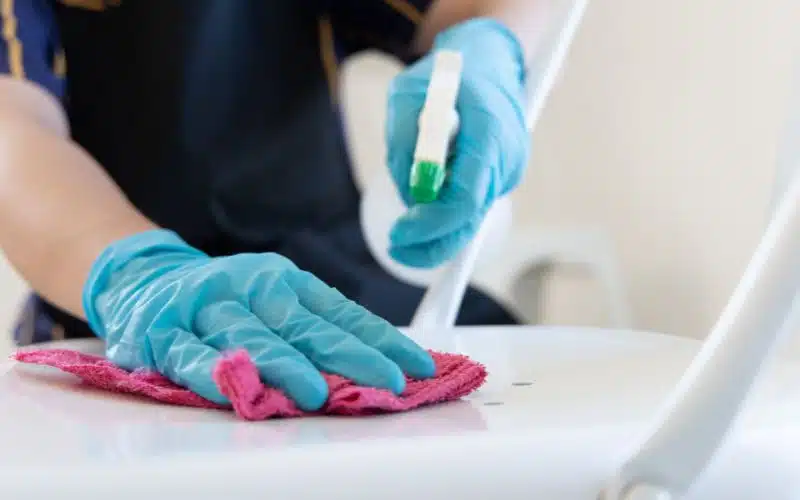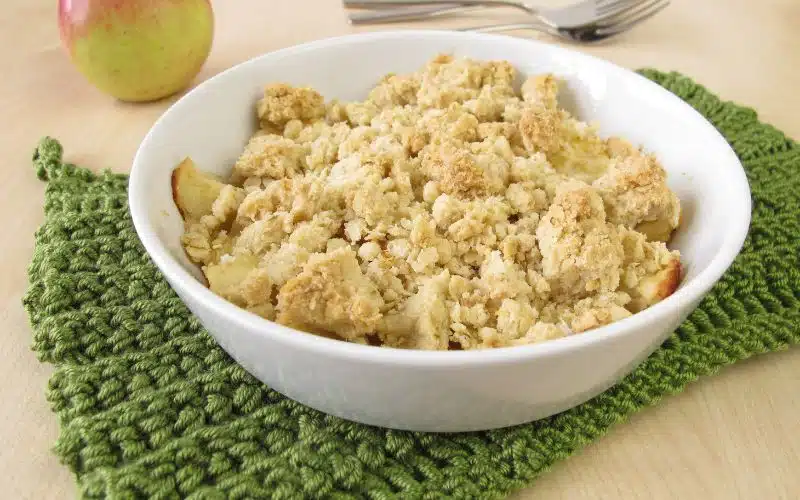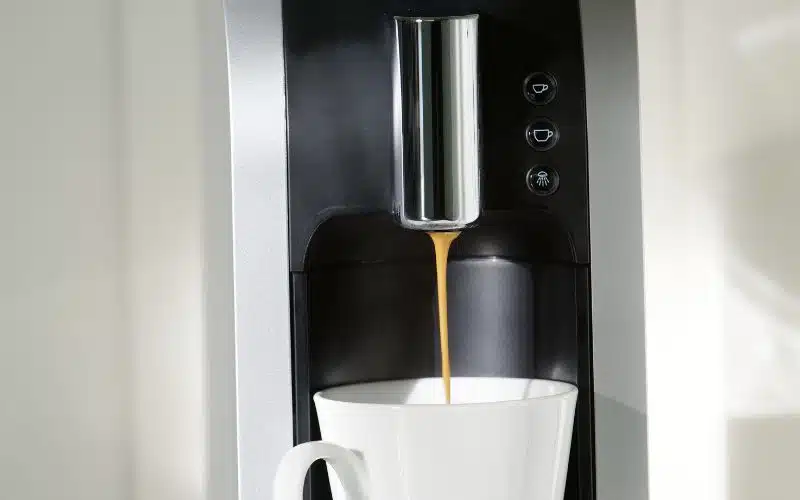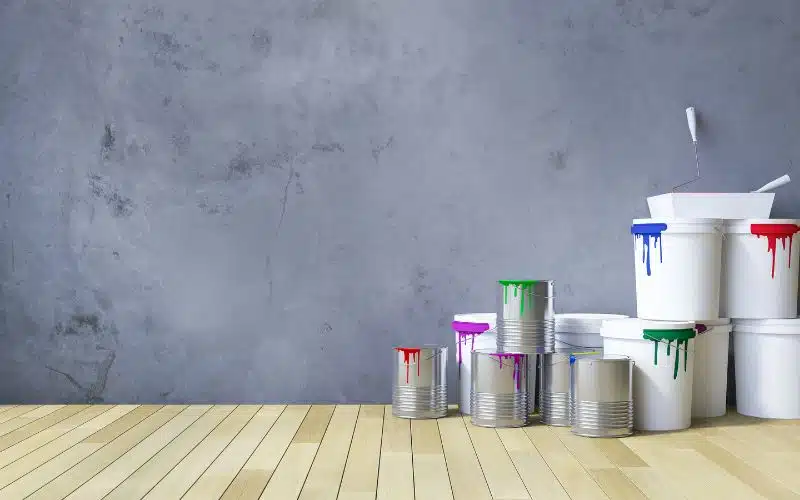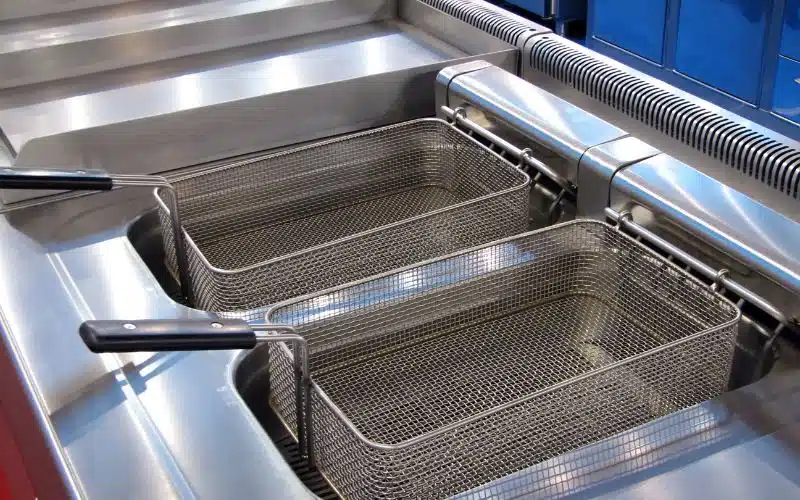The pool is a place for relaxation and refreshment. Particles being at the bottom of the pool can spoil this experience.
On that note, what causes this dust? This article will explain the grey dust and how to get rid of it.
The grey dust at the pool’s bottom is dead algae particles. Some of these algae particles that escape filtering go down to the pool’s bottom. When these algae particles cluster together at the bottom, they look like brown or grey dust.
What is the Dust at the bottom of my Pool?

What you see at the bottom of the pool might be dust. Wind can carry dust particles and deposit them into the pool.
Even swimmers can carry some dust particles before entering the pool. These particles find their way to the pool’s bottom and eventually form a visible layer.
The dust could also be any form of calcium carbonate or calcium dust. Water with low LSI (Langelier Saturation Index) finds more calcium, so it dissolves any calcium it contacts.
LSI measures the amount of calcium saturation in water. Pools with cement walls like plaster, quartz, and pebble have calcium deposits.
Water with low LSI will dissolve the calcium in these walls and cause dust to appear in the pool.
Below, we’ll see other ways that calcium dust can form.
Plaster Dust
One of the more common kinds of calcium dust is plaster dust. A pool with low LSI water will dissolve calcium deposits in the cement walls.
Inside this cement, there’s a highly soluble type of calcium termed calcium hydroxide Ca(OH)2. The pH of Calcium hydroxide is between 12.6 – 12.8.
This pH is high, so it raises the water’s pH whenever it comes into solution. Therefore, the water near the wall will increase in LSI.
After the calcium dissolves, carbonate ions or the water’s Co2 will react with calcium hydroxide to carbonate it.
This reaction produces calcium carbonate, which doesn’t dissolve in water with over 0.00 LSI. Calcium carbonate then materializes like dust, termed plaster dust.
How do I Get Grey Dust Off the Bottom of my Pool?
If you find algae in your pool, the following ways will help you eliminate it.
#1. Brushing the Pool
Brushing off the pool walls and floor will help remove algae adhering to them. Brushing will make the algae float in the pool so it can be filtered out.
You need a soft hair brush if your pool’s walls or floor are made from fiberglass. A steel hair brush will be good for concrete or plaster walls and the bottom.
#2. Pool Vacuuming
There are two ways to vacuum a pool. The first technique is easier, but you need a multiport system to execute it.
This method is very effective in removing algae from the bottom of the pool. A multiport system will remove the infested water entirely from the pool.
You start by putting the system in the “waste setting .” It varies from vacuum to another; some connect to the suction or pressure side.
In this “Vacuuming to waste” technique, the algae or grey dust goes through the hose and pump. The vacuum expels the algae from the pool and bypasses the filter.
This technique prevents clogging in the filter and ensures the algae doesn’t repopulate the water.
Furthermore, placing the simmer and pump basket in position as you vacuum is essential. The baskets will help trap large clumps and prevent damaging the vacuum system.
The second technique does the job in the absence of a multiport system. Here, you send the water through the filter, but the filter will be useless after the task.
Expelling algae through the filter is not as effective because you’ll have to wash the filter repeatedly during the process.
What Does Dead Algae in Pool Look Like?
Algae change to grey or white color once they die, especially after chlorine use. Since they have fine particles, they tend to sink to the pool’s bottom.
Chlorine shock treatment with a clarifier will clear the water and let you see the dead algae.
Algae have some common characteristics like flourishing in warm water and growing well in water without chlorine.
Let’s take a look at some algae and how to treat them.
#1. Yellow Algae
The yellow algae are very common in pools and hard to eliminate. They have a mustard or yellow color and tend to cling to the shady areas of the pool.
Even the tight corners of the steps are good places for them. The algae must come off these locations so the treatment can kill them.
A high dose of chlorine will kill yellow algae, but “Yellow Treat” hastens the process. The yellow treat will stimulate the chlorine to act but, in turn, wear away the chlorine faster.
It is essential to test the chlorine after one day of treatment. If the amount is low, the pool should receive another dose.
After the algae die, the filter traps some of them. However, due to the nature of the algae, others will remain on the pool’s floor. The algae will appear in either brown or grey dust and require vacuuming.
#2. Black Algae
Black algae are often mistaken for stains since they vary between nail cap and coin sizes. Bigger grey patches are not dark algae.
Black algae feel like and resemble tar, and they die after using high chlorine doses. Usually, “Algae Kill” and “Algae Destroyer” have the right amount of concentration to do the job.
The products gradually dissolve granulose chlorine. Before applying, shut off the pump so the water can be still as possible.
Then, discharge the products close to infested areas, so it falls to the floor and covers the algae.
Use a chlorine tablet to rub the algae on the pool’s walls or brush them off so they can fall to the bottom. You can buy Algaecides here.
How to Remove Grey Dust from Button of Pool without Vacuum?
These are some ways to remove grey dust from the pool’s floor without a vacuum.
#1. Filter Method
Pools having filters can easily get rid of grey dust.
- The first thing to do is to turn off the filter.
- Next, carefully clean the filters to prevent debris from blocking the filter. Brush the pool’s walls using the precise type of brush.
- Switch on the filter to drain all the water, including the algae.
#2. Use of Shock Products
This method requires a pool shock chemical, calcium hypochlorite, a gallon of water, hand gloves, and protection goggles.
- Pull on the hand gloves and wear the goggles.
- Pour the shocking chemical (one kilogram) and the calcium hypochlorite into five buckets of water.
- Empty the mixture over the infested areas.
- Ensure that the pump runs between eight to twelve hours. It is advisable to execute this sanitation at night so there’s enough time for the chemical to work.
- The water might be cloudy after the process; keep the pool running for hours so it’ll clear.
#3. Use of Algaecide
Algaecides are operative formulas that restrict algae growth and are simple to use as they don’t need extra tools.
Before using algaecides, switch on the pump so the pool can be in constant circulation.
Wait for a few minutes, then pour some of the algaecides. Let the water pump for a full day so the infested water will disappear.
How to Remove Sand from Pool Bottom?
Wind or swimmers can introduce sand into the pool. You can consider a low-cost option if there’s no filter in the swimming pool.
- Brush the walls and let the sand settle on the floor.
- Get inside the water and swim to the floor to gather the sand.
- Use a dustpan or anything else to remove the pool’s sand.
The following steps will also help you remove sand from the pool bottom.
#1. Prepare your Vacuum
You’ll have to switch the waste setting on the vacuum’s multiport valve. Any other setting will have the sand stuck in the vacuum and possibly spoil the filter.
The waste setting will ensure that the sand and water won’t go into the filter. However, you should note that you’ll lose some pool water. The water won’t rotate back and fill up the pool.
#2. Let the Pool Overfill
The vacuum will pull out a high volume of water, so you can let the pool overflow before starting.
#3. Brush the Particles Together
Before putting on the vacuum, brush off the sand from the walls and the pool’s tight corners.
Take your time to brush those corners that can hold sand. It’ll be easier to vacuum the pool once the sand gathers in one place.
#4. Vacuum the Pool
After gathering the sand, you can switch on your vacuum to pump out the water and the sand.
You can buy a suction-side cleaner or an automatic pool cleaner. Let’s weigh the pros and cons of these cleaners so you can choose.
#5. Suction-side Cleaner
| Pros | Cons |
|---|---|
| They have a “throat” instrument that facilitates the passage of sand and other particles. | It uses the pump’s power to operate, which means it won’t work on low-powered pumps. |
| This cleaner isn’t prone to breaking down. | Only a few of them can climb walls. |
| It doesn’t require a booster pump, thereby reducing electricity costs. | Some of these cleaners can’t facilitate bigger debris like twigs and leaves. |
- Innovative low-flow design makes it ideal for...
- Cyclonic suction for powerful vacuuming and...
- Swiveling hoses are quick-connect style for easy...
- Includes automatic Weir Valve, 90° Twist Lock...
Last update on 2024-01-05 / Affiliate links / Images from Amazon Product Advertising API
#6. Robot Pool Vacuum
| Pros | Cons |
|---|---|
| It uses its contained system to clean the pool. | Expensive to repair after a breakdown. |
| Can climb pool walls for effective cleaning. | This pool cleaner can’t draw in floating debris. |
| Electricity costs are low. | The reach of this cleaner depends on its cable’s length. |
- WIRELESS AND SAFER CLEANING: Say goodbye to wires...
- SUCTION POWER: Dual motors provide suction action...
- SELF-PARKING: Adopting self-parking smart...
- EASY TO USE & CLEAN: Lightweight at just 6.6lbs,...
Last update on 2024-01-05 / Affiliate links / Images from Amazon Product Advertising API
Conclusion
The grey dust at the pool’s bottom is dead algae particles. Dead algae in the pool have white or grey color.
You can get grey dust and sand particles out of the pool by use of algaecide and vacuuming the pool.


